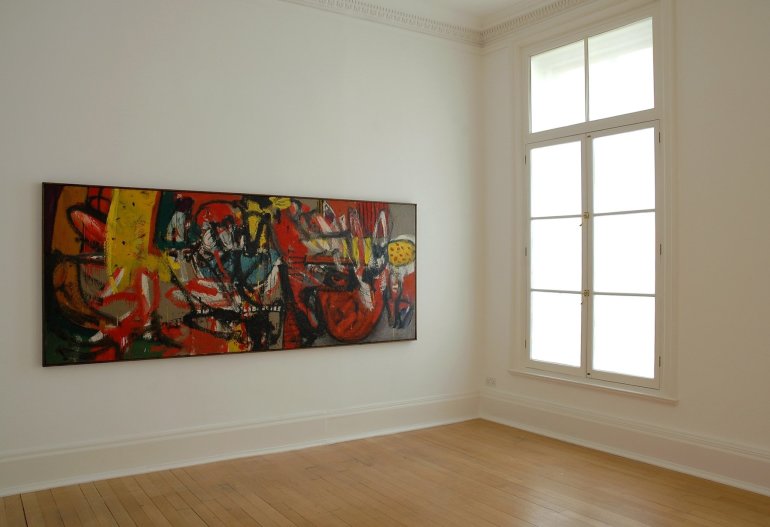Alan Davie 6 Feb - 3 Mar 2007 11 Duke Street, St James's
Painting is very much like improvising on a piano - sitting down and playing, an idea will appear out of putting one note against another, which leads to other notes and before you know where you are, a melodic line has appeared and a harmonic structure presents itself.
Alan Davie
The Directors of Thomas Dane Gallery in collaboration with The Paragon Press are pleased to present paintings from 1955-1967, a seminal period in Alan Davie's practice.
Regarded as one of the most influential British artists and a pivotal link between post-war European art and American abstract expressionism, Davie has persistently pursued a personal pictorial vocabulary based on spontaneity and improvisation. This exhibition brings together 26 early landmark paintings from an important transitional period within the artist's 65 year career.
Between 1947-49 Davie travelled extensively in Europe and took his first trip to America in 1956 where he met Pollock, De Kooning, Kline and Rothko. His 1948 trip took him to Venice for the Biennial in which Peggy Guggenheim displayed her collection in the Greek Pavilion. Here he was not only introduced to, and inspired by the work of Pollock, Klee, and Miró, but his subsequent introduction to the legendary Guggenheim led to a purchase of a work of his and launched his career. Davie states that it was on this trip that he 'woke up and from then on (he) painted non-stop'.
Davie found inspiration in the work of the Surrealist émigrés and also recognised early on the force of the emerging New York School. Although his works of the 50's and 60's are very clearly of this time and share much of the gestural determination of his transatlantic contemporaries, Davie never considered himself part of a particular movement. Rather his objective was, and continues to be, 'a search for a formula for the magical conjuring of the unknowable'.
Influenced by the surrealist strategy of 'automatism', Davie begins his canvases without a predetermined idea, allowing him to tap into unconscious imagery. He would often work on multiple paintings at the same time. For Davie 'the idea comes out of the working' and this is a process of trial and error Davie would build up layers of motifs and conflate an individual iconography of shapes and symbols with exuberant, expressive marks, as in 'Magical Square (Mystical Box)' (1955), and 'Glory,' (1957).
It was in the early 50's that Davie took to the floor, approaching his canvases from above and exuberantly attacking them from all sides. This move also signals a change in scale of the paintings which would increase through the 60s, as seen in his monumental 'Improvisations for a Gay Ghost' series (No.2, No.4 and No.5 or 6).
The freedom and liberation of the 60s comes through in his wild, energetic brush strokes and optimistic colour scale, moving away from the pastel backdrops of the 50s into bolder segments of blue and orange. By the early 60s, in his series of works such as 'Heavenly Bridge', Davie appears to be using a post cubist grid system of organising his compositions into heavily layered panels, vertical, horizontal and diagonal sections, which are disrupted by gestural, easy scribbles and dots of paint. Other works including 'Dream of a Bitch of a Dream' (1960) are busy and urgent paintings of outlined shapes floating before an indeterminate ground, reminiscent of the works of Arshile Gorky and the vibrant splashes of Sam Francis.
In 'Egg Filler' and 'Dog Leg Egg' (1961) one can witness the dynamic interaction between the bursts of emblematic motifs such as the egg and striped tally, petal and spiral. His work takes on a more graphic, pop quality in the early 60s whereby text starts to appear and he uses flat blocks of unmixed colours as in 'Peach Time' (1961) and a joyful interplay of bright, simple shapes as in 'Night or Day We Play' and 'Signs of Life' (1962).
An accomplished jazz musician, Davie has compared his compositional technique in painting to that of jazz improvisation, allowing the artist to depart from the original structure in a loose and expansive way, such as in 'Tiger's Carriage' and his 'Dollygod' series of 1960. It is this approach which allowed Davie to work at a quick, excited pace, tempered only by the striped tally, a register of the lively tempo of his painting.
Alan Davie was born in 1920 in Grangemouth Scotland and studied at Edinburgh College of Art from 1938-1940. He had his first London solo exhibition at Gimpel Fils in 1950 and has since been widely exhibited internationally. In the 1950s Davie taught at the London Central School of Arts and Crafts before taking up a three-year Fellowship at Leeds University. During the 1960s Davie spent most summers in a remote cottage in Cornwall. In 1971 he made his first visit to St Lucia in the Caribbean where he began to spend half of each year. Today Davie is based on Hertfordshire.
A catalogue of the exhibition is available with an essay by William Feaver.


